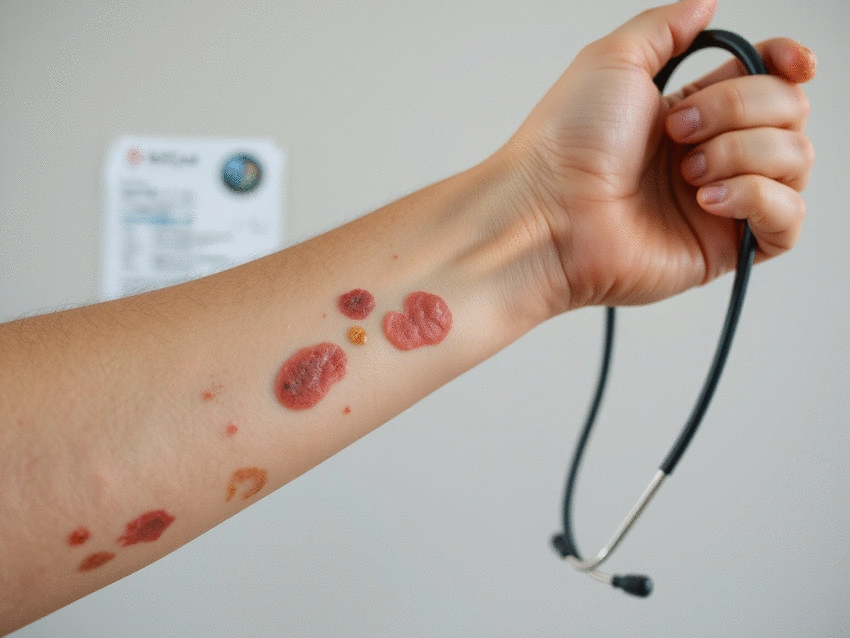Lupus
A severe autoimmune disorder often characterized by distinctive facial rashes.
- Butterfly rash: across cheeks and nose
- Other symptoms: joint pain, fatigue
Understanding autoimmune diseases and their effects can feel overwhelming, but recognizing the connection between these conditions and skin rashes is vital for managing your health effectively. Are you aware of how crucial it is to identify the early signs?
This visual summarizes common autoimmune diseases and their characteristic skin rashes, highlighting key symptoms and affected areas.
A severe autoimmune disorder often characterized by distinctive facial rashes.
A chronic autoimmune condition affecting the skin and overall well-being.
A rare disease impacting muscles and skin, with unique rash locations.
Diverse conditions with distinct skin manifestations requiring tailored understanding.
Primarily joint-focused, but can also lead to various skin complications.
Autoimmune diseases are conditions where the immune system mistakenly attacks the body's own tissues. This can lead to a variety of symptoms, including skin rashes. The immune system usually protects us from infections and diseases, but in autoimmune disorders, it can become an enemy of our own skin, causing inflammation and irritation.
In my journey as a health writer at What Are Rashes, I’ve seen how these conditions can complicate skin health. Individuals affected by autoimmune diseases often face chronic skin issues, making it crucial to understand the connection between the two.
Autoimmune diseases encompass a wide range of disorders, including rheumatoid arthritis, lupus, and multiple sclerosis. Each of these conditions can manifest in various ways, particularly through skin rashes. Skin rashes can present as redness, scaling, or even blistering, depending on the underlying autoimmune disorder.
When the immune system attacks skin cells, it can disrupt the skin barrier, leading to inflammation and the characteristic changes seen in autoimmune-related rashes. This is why recognizing early signs is so important for timely treatment.
The immune response in autoimmune disorders can lead to a cascade of events that affect the skin. When the body mistakenly targets its own tissues, it can result in inflammation and damage to skin cells. This reaction often leads to the development of various skin rashes that can be both uncomfortable and distressing.
For instance, in conditions like lupus, the immune system can create a distinctive "butterfly rash" across the cheeks and nose. Similarly, patients with psoriasis may experience red, scaly patches that can be itchy and painful. Understanding how these immune attacks occur allows us to better address the symptoms, with new immunotherapy strategies offering hope for sufferers.
Lupus is a severe autoimmune disorder that can result in a unique skin manifestation known as the butterfly rash. This rash typically appears across the cheeks and bridge of the nose, resembling a butterfly's wings. People with lupus may also experience other symptoms, such as fatigue and joint pain, making it crucial to maintain a close relationship with healthcare providers.
Being aware of these symptoms can empower individuals to seek help early, which is critical for managing lupus effectively.
Psoriasis is another autoimmune condition that goes beyond skin deep. This chronic disease is characterized by red, raised patches covered with silvery scales. It's essential to know that psoriasis can also affect mental and emotional health due to its visible nature.
Understanding psoriasis is a step towards finding effective treatments and improving one’s overall well-being.
Dermatomyositis is a rare autoimmune disease that primarily affects the skin and muscles. The skin symptoms often include a purplish rash, particularly on the eyelids and knuckles. Recognizing these signs early can help prevent muscle weakness and other complications.
Awareness and understanding of dermatomyositis not only supports effective treatment but also helps those affected feel less isolated in their journey.
Several other autoimmune diseases can lead to skin rashes, including scleroderma, celiac disease, and Sjögren’s syndrome. Each of these conditions can cause unique skin symptoms, emphasizing the importance of understanding individual experiences. Many dermatologists specialize in autoimmune skin diseases, providing tailored care for these diverse conditions.
Being informed about these conditions can empower individuals to recognize signs and seek appropriate care.
Rheumatoid arthritis is primarily known for joint pain, but it can also lead to skin complications. Some individuals may develop rashes or lesions as a result of the disease or its treatments. Understanding this connection can be essential for comprehensive care.
Incorporating skin health into the broader context of rheumatoid arthritis management can greatly improve quality of life.
Did you know? Keeping a detailed journal of your skin's reactions can greatly assist in identifying triggers related to autoimmune skin rashes. Documenting changes in your skin, diet, and stress levels can help you and your healthcare provider tailor a more effective management plan. Early recognition and understanding of your skin's signals are key to improving your overall health!
In this article, we’ve explored the intricate relationship between autoimmune diseases and skin rashes. We’ve learned that autoimmune conditions can cause the immune system to mistakenly attack skin cells, leading to various rashes and symptoms. Recognizing the signs early is crucial for effective management and treatment!
From lupus and psoriasis to lesser-known conditions, understanding the symptoms and triggers of these diseases can empower you. Whether it’s the distinct butterfly rash of lupus or the scaling associated with psoriasis, awareness is the first step toward a healthier skin journey.
Knowing when to consult a healthcare professional is vital. Here are some key circumstances where you should seek medical help regarding skin rashes:
If you find yourself experiencing any of these situations, don’t hesitate to reach out to a healthcare provider. Early intervention can make a significant difference in managing autoimmune skin conditions!
Staying informed is key to understanding autoimmune diseases. Here are some reputable resources to explore:
These organizations provide valuable information on various autoimmune disorders, research updates, and patient support, helping you stay informed and empowered!
Your experiences matter, and sharing them can foster a supportive community. I encourage you to connect with others facing similar challenges—whether through social media or local support groups. Have you dealt with a skin rash linked to an autoimmune disease? Your story could help someone else navigate their journey!
Let’s work together to spread awareness and provide support for those dealing with these conditions. Remember, you’re not alone in this. Every voice contributes to a greater understanding of autoimmune diseases and their impact on our skin health.
Here is a quick recap of the important points discussed in the article:


